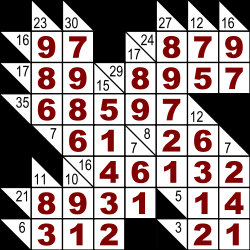

Kakuro or Kakkuro or Kakoro (Japanese: カックロ) is a kind of logic puzzle that is often referred to as a mathematical transliteration of the crossword. Kakuro puzzles are regular features in many math-and-logic puzzle publications across the world. In 1966,[1] Canadian Jacob E. Funk, an employee of Dell Magazines, came up with the original English name Cross Sums [2] and other names such as Cross Addition have also been used, but the Japanese name Kakuro, abbreviation of Japanese kasan kurosu (加算クロス, "addition cross"), seems to have gained general acceptance and the puzzles appear to be titled this way now in most publications. The popularity of Kakuro in Japan is immense, second only to Sudoku among Nikoli's famed logic-puzzle offerings.[2]
The canonical Kakuro puzzle is played in a grid of filled and barred cells, "black" and "white" respectively. Puzzles are usually 16×16 in size, although these dimensions can vary widely. Apart from the top row and leftmost column which are entirely black, the grid is divided into "entries"—lines of white cells—by the black cells. The black cells contain a diagonal slash from upper-left to lower-right and a number in one or both halves, such that each horizontal entry has a number in the half-cell to its immediate left and each vertical entry has a number in the half-cell immediately above it. These numbers, borrowing crossword terminology, are commonly called "clues".
The objective of the puzzle is to insert a digit from 1 to 9 inclusive into each white cell so that the sum of the numbers in each entry matches the clue associated with it and that no digit is duplicated in any entry. It is that lack of duplication that makes creating Kakuro puzzles with unique solutions possible. Like Sudoku, solving a Kakuro puzzle involves investigating combinations and permutations. There is an unwritten rule for making Kakuro puzzles that each clue must have at least two numbers that add up to it, since including only one number is mathematically trivial when solving Kakuro puzzles.
At least one publisher[3] includes the constraint that a given combination of numbers can only be used once in each grid, but still markets the puzzles as plain Kakuro.
Some publishers prefer to print their Kakuro grids exactly like crossword grids, with no labeling in the black cells and instead numbering the entries, providing a separate list of the clues akin to a list of crossword clues. (This eliminates the row and column that are entirely black.) This is purely an issue of image and does not affect either the solution nor the logic required for solving.
In discussing Kakuro puzzles and tactics, the typical shorthand for referring to an entry is "(clue, in numerals)-in-(number of cells in entry, spelled out)", such as "16-in-two" and "25-in-five". The exception is what would otherwise be called the "45-in-nine"—simply "45" is used, since the "-in-nine" is mathematically implied (nine cells is the longest possible entry, and since it cannot duplicate a digit it must consist of all the digits from 1 to 9 once). Curiously, both "43-in-eight" and "44-in-eight" are still frequently called as such, despite the "-in-eight" suffix being equally implied.
- ^ Timmerman, Charles (2006). The Everything Kakuro Challenge Book. Adams Media. p. ix. ISBN 9781598690576. Retrieved November 18, 2018.
- ^ a b "Kakuro history". Retrieved November 18, 2018.
- ^ "Sudoku From Denksport". Keesing Group B.V. Retrieved November 18, 2018.